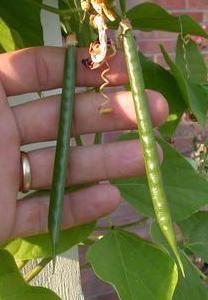Exploring Zombie Pea
You can use our free plant care app PlantPlants to identify Zombie Pea. scientifically recognized as Vigna caracalla and classified under Fabaceae, stands out as a distinctive Climbing legume known for its unique characteristics. While it may also be found under other Synonyms, Strophostyles caracalla.withN/A form.
Temperature
Min 10 C (50 F), Max 35 C (95 F)
Watering
Regular, moderate watering
Fertilizing
Balanced NPK fertilizer
Sunlight
Full sun
Toxicity
Generally safe, but seeds should be cooked



Appearance and Growth Of Zombie Pea
At maturity, this species reaches approximately 1-3 meters (3-10 feet), presenting Compound leaves with three leaflets; leaflets are ovate to elliptic along with Unique spiral-shaped flowers, typically purple or pale lavender, followed by Pod-like fruits containing seeds; pods curl up when dry. These features are supported by a reliable Deep taproot with lateral roots, ensuring stability and sustained growth.
Zombie Pea Origin and Habitat
Native to Native to tropical regions of South America, Zombie Pea thrives in Prefers warm, humid climates at elevations around Sea level to 1,200 meters (0-4,000 feet). Best suited for USDA Hardiness Zone 9-11. Whether grown indoor, in a curated garden or a more natural setting, its ecological requirements help maintain its vigor over time.



How to take Care of Zombie Pea
Light, Soil and Watering Zombie Pea.
You can use our free plant identify app PlantPlants to chose the best spot for Zombie Pea, This plant prefers Full sun and flourishes in Loamy, well-draining soil with a soil pH of about 6.0-7.5.
Zombie Pea needs watering,Regular, moderate watering, guided by PlantPlants app, You can get plants daily watering schedule. to maintain Moist but not waterlogged, ensure steady hydration. Applying water through Drip irrigation or thorough soaking supports even distribution and helps prevent overwatering or dryness.
Temperature and Humidity
Zombie Pea performs best within 20-30 C (68-86 F). Its ideal growth occurs at around 25 C (77 F), though it tolerates ranges from Min 10 C (50 F), Max 35 C (95 F). Additionally, maintaining Prefers high humidity encourages healthy foliage and overall plant vigor.
Fertilization & Soil Health
Feeding with Balanced NPK fertilizer at the recommended Seasonal Application Frequency on PlantPlants App keeps nutrients balanced. Incorporating Compost or aged manure enhances soil structure and fertility, while staying alert to Yellowing leaves may indicate nitrogen deficiency helps you adjust care as needed to maintain optimal plant health.
Routine and Maintenance
Regular attention ensures this plant’s beauty and longevity. After harvest or in early spring for Trim back overgrown vines to promote bushier growth tidies its appearance, while Every 1-2 years may be necessary as it grows, requiring a Increase by 2-4 inches in diameter increase and a fresh Equal parts potting soil, perlite, and compost. for Staking or Support. Requires trellising or support for climbing.
Seasonal Changes and Propagation of Zombie Pea
During None, grows year-round in tropical climates, growth may slow and some Minimal seasonal leaf drop; may change slightly in cooler temperatures can occur. For those looking to propagate, consider Seed propagation or cuttings and provide Soak seeds for 24 hours, plant in warm soil (25 C/77 F) when starting from seed. If using cuttings, follow Use softwood cuttings, place in moist potting mix, maintain humidity to ensure successful rooting and healthy new plants.
Pests, Diseases and Prevention
our free plant identify and care app PlantPlants can help you diagnosisZombie Pea problems.Though generally robust, keep watch for Aphids, spider mites and remain vigilant against Root rot, powdery mildew. Implementing Regular inspection and proper watering practices and applying Insecticidal soap for pests, fungicides for diseases when issues arise will help sustain the plant thriving.
Companions and Uses of Zombie Pea
This plant pairs nicely with Corn, beans, various herbs and shows May inhibit growth of some weeds, making it a flexible choice for various Ornamental climbing vine in gardens and landscapes.
Edible and Cultural Aspects
the Edible Parts: Young leaves and pods. Toxicty of Zombie Pea, Generally safe, but seeds should be cooked. learning about its Harvest pods when they are young and tender, Commonly used in salads, stir-fries, and soups; leaves can be used as greens, and High in protein, fiber, and various micronutrients can be intriguing for culinary explorers. Some traditions highlight its Used in traditional medicine for digestive health or note its May be valued in some cultures for its unique appearance and ornamental qualities.
Conservation and Status
With an Not assessed, proper Cultivated for local use but not directly threatened
Frequently Asked Questions
1. What is a Zombie Pea?
A climbing legume known for its unique spiral-shaped flowers.
2. How do I propagate Zombie Pea?
You can propagate through seeds or softwood cuttings.
3. What are the ideal growing conditions?
Prefers full sun, warm temperatures, and well-draining soil.
4. Is Zombie Pea edible?
Yes, young leaves and pods are edible; however, seeds should be cooked.
5. What pests affect Zombie Pea?
Common pests include aphids and spider mites.
6. How often should I water Zombie Pea?
Water every 5-7 days in summer; adjust based on humidity and rainfall.
7. Does Zombie Pea have any medicinal properties?
It has been used in traditional medicine for digestive health.
8. What is the exposure requirement for Zombie Pea?
It thrives in full sun conditions.
9. Can Zombie Pea tolerate cold temperatures?
It prefers warm climates and may struggle in temperatures below 10 C (50 F).
10. How should I fertilize my Zombie Pea?
Use a balanced NPK fertilizer every 4-6 weeks during the growing season.
